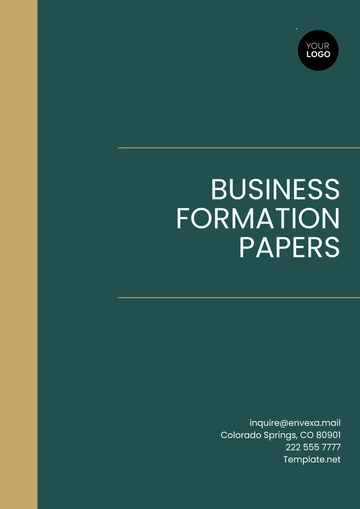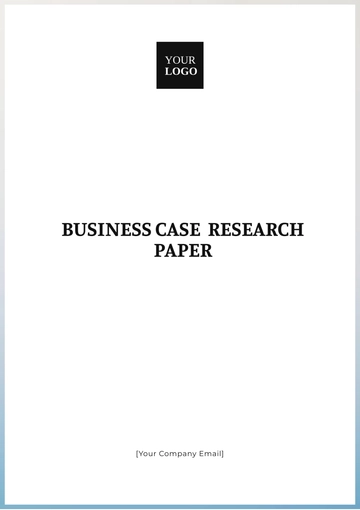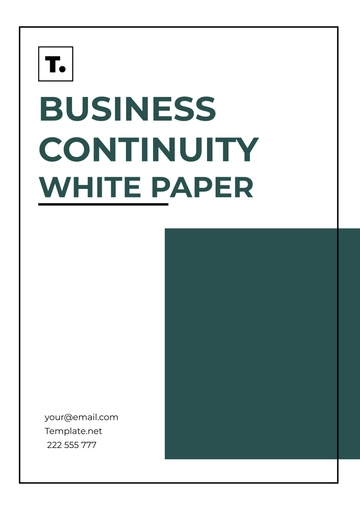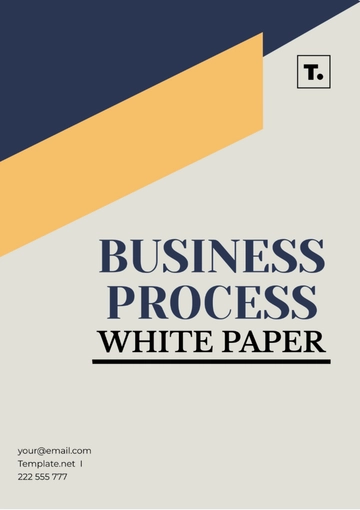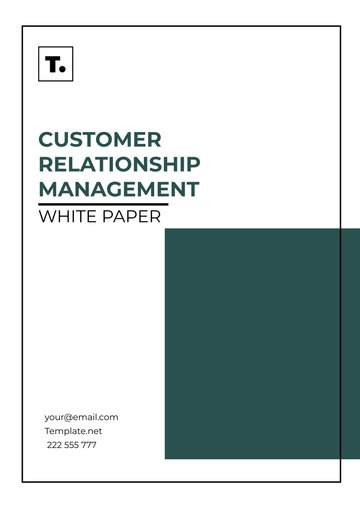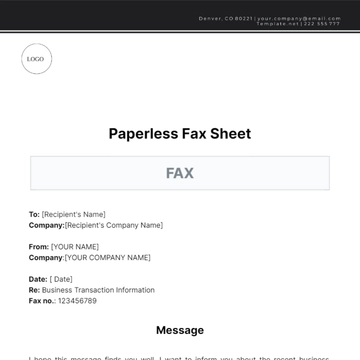Free Customer Relationship Management White Paper

Customer Relationship Management White Paper: Unveiling Effective Strategies
Prepared by: [Your Name]
For: [Your Company Name]
Date: [Date]
Department: [Your Department]
I. Executive Summary

This white paper template is specifically designed to guide the creation of a comprehensive document focused on Customer Relationship Management (CRM). It provides a structured format for addressing key aspects such as problem identification, methodology, findings, and recommendations related to CRM strategies and practices.
Problem Statement: Briefly describe the challenges or issues in managing customer relationships that this white paper aims to address.
Objective: Outline the goal of the white paper, whether it's to analyze current CRM practices, propose improvements, or provide insights into customer engagement strategies.
Key Findings: Highlight the main discoveries or insights obtained through research, analysis, or observations related to CRM.
Recommendations: Summarize proposed solutions or actions to enhance CRM effectiveness based on the findings.
II. Introduction
Introduce the topic of Customer Relationship Management in detail, providing background information on its significance in modern business operations. Define the scope of the white paper and clarify its purpose in guiding organizations toward effective customer relationship management practices.
Background: Offer insights into the evolution and importance of CRM in today's business landscape.
Scope: Define the boundaries of the white paper's focus, outlining the specific areas of CRM strategy, implementation, or optimization to be addressed.
Purpose: Clarify the objectives of the white paper, whether it's to provide guidance, propose solutions, or present research findings related to CRM.
III. Problem Description
Detail the challenges and issues organizations face in managing customer relationships effectively. Use data, research findings, and real-world examples to illustrate the significance and implications of these challenges.
Current Situation: Describe the prevailing state of CRM practices in organizations, highlighting areas of inefficiency or shortcomings.
Impact: Explain how ineffective CRM practices affect organizations, customers, and stakeholders.
Challenges: Identify the main obstacles or difficulties encountered in implementing successful CRM strategies.
IV. Methodology
Outline the methodologies used to gather information, conduct research, and analyze data relevant to CRM. This section provides transparency regarding the approach taken to derive insights and recommendations presented in the white paper.
Research Methods: Describe the techniques, tools, and processes used to collect data and gather insights into CRM practices.
Data Analysis: Explain the methods employed to analyze CRM data and derive meaningful conclusions.
Sources: List the primary sources of information, including research studies, industry reports, and organizational data utilized in the white paper.
V. Findings
Present key findings related to CRM practices, customer behavior, and organizational strategies in a clear and organized manner. Utilize visual aids such as charts, graphs, and tables to enhance understanding and readability.
Caption: Extent of Problem: Comparison of Challenges Faced
Finding 1: Describe the primary discovery or insight obtained through research and analysis.
Finding 2: Detail additional key findings relevant to CRM effectiveness.
Additional Findings: Summarize other significant discoveries contributing to the understanding of CRM dynamics.
VI. Solutions and Recommendations
Based on the findings, offer solutions and recommendations to address the problem. This section should provide actionable advice that [Your Company Name] or industry stakeholders can implement.
Caption: Trend Analysis: Changes in CRM Practices Over Time
Solution 1: Detail the first proposed solution or strategic recommendation.
Solution 2: Explain additional solutions or recommendations aimed at enhancing CRM effectiveness.
Implementation Plan: Provide a step-by-step plan for implementing the recommended solutions, including timelines, responsibilities, and success metrics.
VII. Conclusion
Summarize the key insights, findings, and recommendations presented in the white paper, emphasizing the importance of effective CRM in driving business success. Reinforce the value of implementing proposed solutions to address challenges and capitalize on opportunities in customer relationship management.
VIII. References
Smith, John. "The Evolution of Customer Relationship Management: A Comprehensive Review." Journal of Business Strategies, vol. 30, no. 2, 2022, pp. 45-62.
Brown, Emily. "Challenges and Opportunities in Modern CRM Practices." International Journal of Customer Relationship Marketing and Management, vol. 15, no. 3, 2023, pp. 78-93.
Johnson, David. "CRM Implementation Strategies: A Comparative Analysis." Journal of Marketing Technology and Innovation, vol. 18, no. 1, 2021, pp. 102-117.
Patel, Sarah. "Data Analytics in Customer Relationship Management: Trends and Future Directions." Journal of Data Science and Customer Analytics, vol. 5, no. 4, 2024, pp. 30-45.
White, Michael. "The Impact of Technology on CRM Effectiveness: A Meta-Analysis." Journal of Information Systems Management, vol. 22, no. 3, 2020, pp. 134-149.
XYZ Consulting Group. "State of CRM Report 2023." XYZ Consulting Group, 2023.
IX. Appendix
Include supplementary materials supporting the content of the white paper, such as detailed data tables, technical descriptions, or additional research findings. Enhance the comprehensiveness and credibility of the white paper by providing access to relevant supporting documentation.
- 100% Customizable, free editor
- Access 1 Million+ Templates, photo’s & graphics
- Download or share as a template
- Click and replace photos, graphics, text, backgrounds
- Resize, crop, AI write & more
- Access advanced editor
Unlock the secrets to superior customer relationships with Template.net's white paper template. Fully editable and customizable, it's tailored to suit your CRM needs perfectly. With the added advantage of being editable in our AI tool, this template equips you to forge stronger connections with your clientele. Elevate your CRM strategy with ease.

